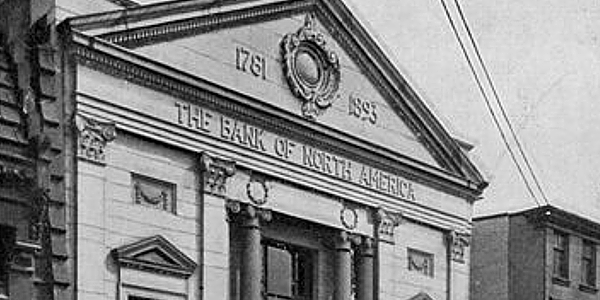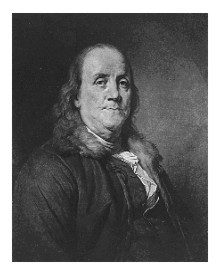Sponsor this page. Your banner or text ad can fill the space above.
Click here to Sponsor the page and how to reserve your ad.
-
Timeline
1781 Detail
May 26, 1781 - The Bank of North America is incorporated in Philadelphia by an act of Congress to help stabilize the issuance of paper currency. It was capitalized in 1781 with $400,000.

It was not known at the time whether the Continental Congress even had such an authority to charter. Robert Morris had been an early proponent of establishing a private bank in Philadelphia prior to the revolution; Alexander Hamilton would join that cause after war broke out. Through the first years of war, the financial conditions in the new nation were deteriorating. Various plans to finance the war, to pay government expenditures, were hatched and failing, including lotteries, loans from foreign lands, and paper money, that by 1779, had been discounted to one eighth of its par value.
Hamilton's first plan was far too ambitious to succeed. He wanted a banking institution capitalized with two hundred million dollars, known as the "Company of the Bank of the United States," and chartered by Congress for ten years. That plan got nowhere. However, by 1780, the financial condition of the country and its army were in dire need of capital. The could not fund the war through increased taxes; they were already too high. On June 8, 1780, a group of private citizens in Philadelphia held a meeting at the Coffee-House, where it was decided to hold a subscription drive to fund a bank. Within nine days, four hundred pounds of hard money, and one hundred and one thousand dollars of Continental money was raised from citizens. By June 17, members of Congress weighed in, fresh from news of the loss at Charleston; the scheme must be larger, with three hundred thousand Pennsylvania money in real currency to be raised. A second meeting was held at City Tavern. The money raised would be backed by bonds, a bank formed, and the money used by buy and transport food to the army. It was to be known as the Pennsylvania Bank. The most prominent men who subscribed were Robert Morris and Blake McClenachan with 10,000 pounds each. This bank began operation on July 17, 1780 and remained open for eighteen months. However, the Bank of Pennsylvania would not be enough to stem the tide of decreasing financial security for the United States.

The Bank of North America Begins
By January of 1781, the Army had not been paid and the troops at winter quarters in Morristown decided to mutiny. Washington halted their mutiny, however, that did not stem the simple fact that the financial conditions in the new nation still at war remained dire. Continental money was now worth one percent of its par value. Tory papers by May 1781 declared Congress bankrupt and shopkeepers began to refuse payment in any other than gold and silver.
But by this time, prospects for the government itself had begun to improve. In March, the Articles of Confederation had been ratified, improving its structure, and Congress now had a common treasury, not state oriented, that could borrow and pay bills. Robert Morris was now Superintendant of Finance with Hamilton on board suggesting an alteration to his original proposal, a central bank with three million dollars available. Morris still thought that plan too ambitious and proposed his own to Congress on May 17, 1781.
The plan for the central national bank by Morris included four hundred thousand dollars in capital raised by gold and silver, twelve directors, and met with favor by a Congressional committee on May 26. A vibrant debate in Congress ensued. James Madison opposed; he though Congress was overstepping its bounds. The resolution would pass with a bare majority, using yes votes from New Hampshire, New Jersey, Maryland, Virginia, North Carolina, South Carolina, and Georgia.
Subscriptions to fund the capital were slow to materialize; it was a risky venture. By fall of 1781, subscriptions grew, with many of those involved in the Bank of Pennsylania transferring their capital to the Bank of North America. An organization meeting was held at City Tavern on November 1, 1781. Thomas Willing, a busines partner of Robert Morris and former Mayor of Philadelphia, was elected President of the Bank of North America. By December 31, 1781, Congress approved its incorporation, despite the subscription goal being not yet filled. On January 7, 1782 (some sources state January 4), it began operations at a storefront on Chestnut Street in Philadelphia, where it remained for sixty-five years. A subsequent building was constructed in 1893, shown above and below, but has since been demolished. There were six employees, recieving from $160 (porter) to $1,000 (cashier) per year. The accounts were kept in Mexican dollars.
The role of the Bank of America as its de facto central bank would be superceded by the establishment of the First Bank of the United States in 1791.
Full Text, Resolution to Establish the Bank of North America
Resolved, That Congress do approve of the plan
for establishing a national bank in these United
States, submitted by Mr. Robert Morris the 17th
May, 1781, and that they will promote and sup-
port the same by such ways and means from time
to time as may appear necessary for the institution
and consistent with the public good.
Resolved, That the subscribers to the said bank
shall be incorporated agreeably to the principles
and terms of the plan, under the name of the
President, Directors, and Company of the Bank
of North America, so soon as the subscription shall be filled, the directors and president chosen,
and application made to Congress for that purpose
by the president and directors elected.
Resolved, That it be recommended to the several
States, by proper laws for that purpose, to provide
that no other Bank or Bankers shall be established
or permitted within the said States respectively
during the war.
Resolved, That the notes hereafter to be issued
by the said bank, payable on demand, shall be re-
ceivable in payment of all taxes, duties, and debts
due, or that may become due and payable to the
United States.
Resolved, That Congress will recommend to the
several Legislatures to pass laws making it felony
without benefit of clergy, for any person to counter-
feit bank-notes, or to pass such notes, knowing them
to be counterfeited; also making it felony with-
out benefit of clergy, for any president, inspector,
director, officer, or servant of the bank to convert
any of the property, money, or credit of the said
bank to his own use, or in any other way to be
guilty of fraud or embezzlement, as officers or ser-
vants of the bank.
Photo above: Lithograph of the 1893 built Bank of North America, date unknown, Helen C. Perkins. Courtesy Wikipedia Commons. Below: The bank facade in 1959 prior to its destruction, 1959, Philadelphia Historical Commission, Historic American Buildings Survey. Courtesy Library of Congress. Sources: History of the Bank of North America, 1882, Lawrence Lewis, Jr.; Library of Congress; "Bank of North America," Robert F. Smith, The Encyclopedia of Greater Philadelphia; Wikipedia Commons.





